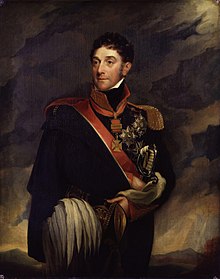Stapleton Cotton
|
Field Marshal The Right Honourable The Viscount Combermere GCB GCH KSI PC |
|
|---|---|
 |
|
| Governor of Barbados | |
|
In office 1817–1820 |
|
| Monarch | George III |
| Preceded by | John Foster Alleyne (acting) |
| Succeeded by | John Brathwaite Skeete (acting) |
| Personal details | |
| Born | 14 November 1773 Lleweni Hall, Denbighshire |
| Died | 21 February 1865 (aged 91) Clifton, Bristol, Bristol |
| Nationality | British |
| Alma mater | Westminster School |
| Awards |
Knight Grand Cross of the Order of the Bath Knight Grand Cross of the Royal Guelphic Order Knight Companion of the Order of the Star of India |
| Military service | |
| Allegiance |
|
| Service/branch |
|
| Years of service | 1790–1830 |
| Rank | Field Marshal |
| Commands |
25th Light Dragoons 16th Light Dragoons Commander-in-Chief, Ireland Commander-in-Chief, India |
| Battles/wars |
French Revolutionary Wars Fourth Anglo-Mysore War Peninsular War |
Field Marshal Stapleton Cotton, 1st Viscount Combermere GCB GCH KSI PC (14 November 1773 – 21 February 1865), was a British Army officer, diplomat and politician. As a junior officer he took part in the Flanders Campaign, in the Fourth Anglo-Mysore War and in the suppression of Robert Emmet's insurrection in 1803. He commanded a cavalry brigade in Sir Arthur Wellesley's Army before being given overall command of the cavalry in the latter stages of the Peninsular War. He went on to be Commander-in-Chief, Ireland and then Commander-in-Chief, India. In the latter role he stormed Bharatpur—a fort which previously had been deemed impregnable.
Cotton was born at Lleweni Hall in Denbighshire, the second surviving son of Sir Robert Salusbury Cotton, 5th Baronet and Frances Cotton (née Stapleton). When he was eight, Cotton was sent to board at the grammar school in Audlem some 8 miles (13 km) from the family's estate at Combermere Abbey, where he was tutored by the headmaster, the Reverend William Salmon, who was also chaplain of the private Cotton chapel outside the estate gates. A quick, lively boy, he was known by his family as ‘Young Rapid,’ and was continually in scrapes. After three years in Audlem, he continued his education at Westminster School where he joined the fourth form under Dr. Dodd and his contemporaries included future soldiers Jack Byng, Robert Wilson and the poet Robert Southey. He was then sent to Norwood House, a private military academy in Bayswater, which was run by a Shropshire militiaman, Major Reynolds, an acquaintance of his father's. On 26 February 1790, Cotton's father obtained for him a second-lieutenancy, without purchase, in the 23rd Regiment of Foot or Royal Welch Fusiliers, which he joined in Dublin in 1791. He was promoted to lieutenant in the 77th Regiment of Foot on 9 April 1791 and, having transferred back to the 23rd Regiment of Foot on 13 April 1791, he was promoted to captain in the 6th Dragoon Guards on 28 February 1793. He served with his regiment at the Siege of Dunkirk in August 1793 and at the Battle of Beaumont in April 1794 under the Duke of York during the Flanders Campaign. He became a major in the 59th Regiment of Foot on 28 April 1794 and commanding officer of the 25th Light Dragoons (subsequently 22nd) with the rank of lieutenant colonel on 27 September 1794.
...
Wikipedia
